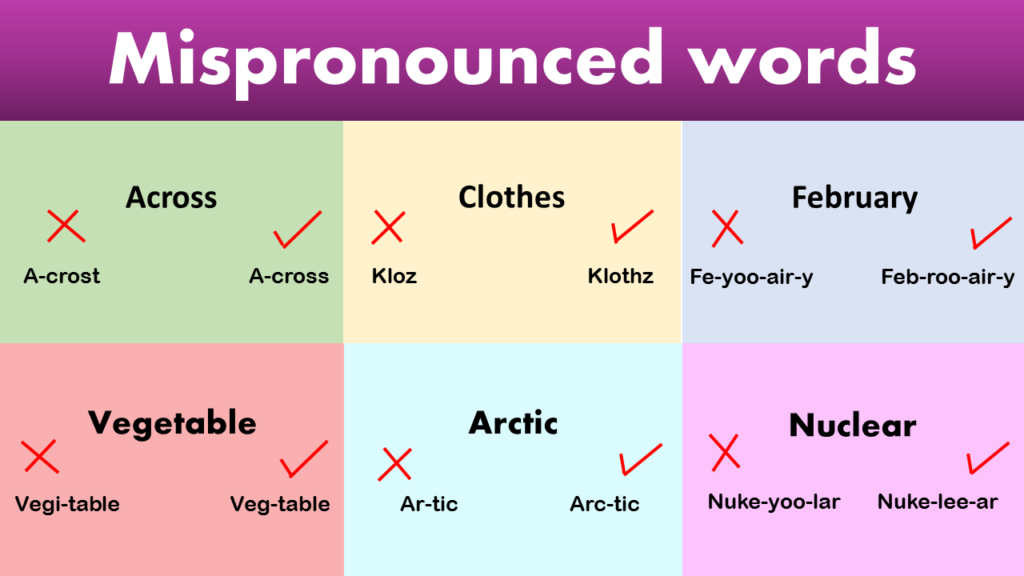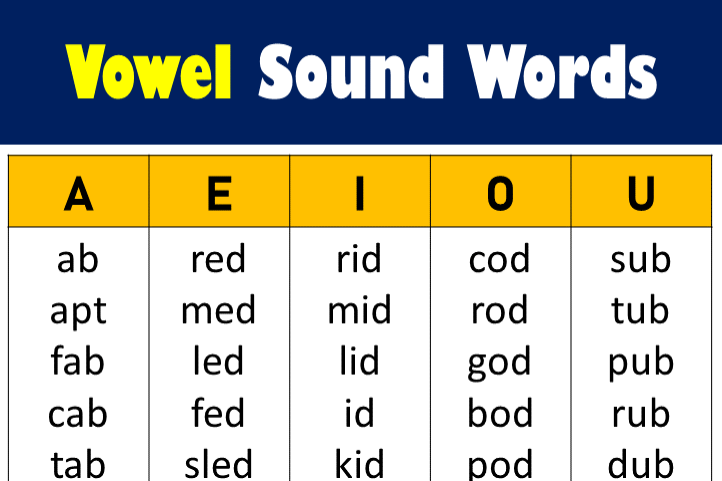Before we embark on our exploration of the list of vowel sound words, it’s important to grasp the concept of vowel sounds. Vowels are speech sounds produced without significant constriction or closure in the vocal tract, allowing for the free flow of air. These sounds form the core of syllables and words, defining their pronunciation and contributing to the overall rhythm of spoken language.
English contains several vowel sounds, which can be broadly classified into two categories: short vowels and long vowels. Each category includes multiple vowel sounds, some of which may overlap. Additionally, there are diphthongs, which are combinations of two vowel sounds within the same syllable. Let’s explore each of these categories in more detail.
Short Vowel Sound Words
Short vowel sound words are words in which the vowel sounds are pronounced briefly and typically sound like their letter names. Here’s a list of words that contain short vowel sounds:
Short “A” Sound:
- Rat
- Bat
- Jam
- Pan
- Hat
- Mat
- Dad
- Sad
- Fan
- Cat
Short “E” Sound:
- Tell
- Hen
- Net
- Bed
- Left
- Bell
- Pen
- Red
- Well
- Pet
Short “I” Sound:
- Kid
- Sit
- Fix
- Zip
- Mix
- Lip
- Bit
- Lid
- Big
- Pig
Short “O” Sound:
- Dot
- Mom
- Dot
- Box
- Top
- Fox
- Log
- Pot
- Dog
- Hot
Short “U” Sound:
- Fun
- Duck
- Bug
- Rug
- Cut
- Hut
- Nut
- Cup
- Tub
- Sun
Long Vowel Sound Words
Long vowels are pronounced with an extended sound, often influenced by the presence of the silent “magic e” (also known as a silent final e). These vowels are typically found in single-syllable words or in stressed syllables of multi-syllable words. Here are the five primary long vowel sounds in English:
Long “A” Sound:
- Jade
- Brave
- Flake
- Plate
- Scale
- Lake
- Grape
- Bake
- Train
- Cake
Long “E” Sound:
- Sweet
- Repeat
- Treat
- Dream
- Bee
- Tree
- Beach
- Peach
- Feet
- Steam
Long “I” Sound:
- Tie
- Lie
- High
- Fine
- Light
- Pie
- Lime
- Bike
- Night
- Time
Long “O” Sound:
- Note
- Boat
- Rose
- Road
- Home
- Load
- Goat
- Bone
- Dome
- Coat
Long “U” Sound:
- Mule
- June
- Rule
- Tube
- Cube
- Fuse
- Flute
- Use
- Cute
- Blue
These words generally contain short vowel sounds, but the pronunciation can vary based on accents and dialects.
Diphthongs
Diphthongs are combinations of two vowel sounds within the same syllable. They often result from the gliding movement of the tongue from one vowel sound to another. In English, some common diphthongs include:
/aʊ/ – The “house” sound
- house
- mouse
- spouse
- out
- south
/ɔɪ/ – The “coin” sound
- coin
- join
- point
- toy
- enjoy
/aɪ/ – The “ice” sound
- ice
- nice
- spice
- price
- slice
/eɪ/ – The “rain” sound
- rain
- train
- brain
- gain
- pain
Tips for Using Vowel Sounds in Sentences
Using vowel sounds effectively in a sentence can enhance the rhythm and flow of your writing or speech. Vowel sounds are produced when the vocal cords vibrate without any significant constriction or closure in the vocal tract. Here are a few tips for using vowel sounds in sentences:
- Assonance: Assonance involves the repetition of vowel sounds within words. It can create a pleasant musical quality. For instance: “The rain in Spain stays mainly in the plains.”
- Alliteration: Alliteration is the repetition of initial consonant sounds in neighboring words. You can incorporate vowel sounds into alliteration for added effect. For example: “Silent and serene, the sea sparkled in the sun.”
- Rhyme: Rhyming words often share similar vowel sounds. For example: “The moon’s soft tune.”
- Emphasis and Rhythm: Vowel sounds can be used to emphasize certain words or create a rhythmic pattern in your writing. Choose words with long or stressed vowels for emphasis, and shorter vowels for a faster pace.
- Contrast: Using different vowel sounds can help you contrast ideas or create a distinction between elements. For example: “The fiery sun warmed the icy ocean.”
- Imagery and Mood: Different vowel sounds can evoke different emotions or imagery. Softer, smoother vowel sounds can create a calm and peaceful atmosphere, while sharper or harsher vowel sounds might convey tension or excitement.
- Repetition and Parallelism: Repeating a particular vowel sound can add a sense of unity or parallelism to your sentence. For example: “He dreams of seashells by the seashore.”
- Punctuation and Pauses: Consider using punctuation marks like dashes or ellipses to break up sentences and allow the reader to focus on specific vowel sounds.
Remember, the key is to use vowel sounds intentionally to achieve the desired effect in your writing or speech. Experiment with different combinations of words and sounds to create the rhythm and mood you want.
Vowel Sound Word In A Sentence
- The eagle is a majestic bird of prey.
- The athlete won a gold medal.
- The airplane soared through the sky.
- The igloo provided shelter in the cold.
- The opera singer had a powerful voice.
- The eagle soared high in the sky.
- The umbrella shielded her from the rain.
- He played a sweet melody on his guitar.
- The ocean waves crashed against the shore.
- The open book lay on the table.
- The eager child eagerly opened the gift.
- The unique statue was a work of art.
- His voice echoed through the cave.
- The oak tree provided shade in the park.
- The owl hooted in the night.
- The island was surrounded by clear water.
- The oyster produced a precious pearl.
- The ivy climbed up the wall.
- The auction drew a large crowd.
- She wore a beautiful earring to the party.
- The elevator took us to the top floor.
- The urban landscape was bustling with activity.
- The astronomer studied the stars.
- The igloo is a traditional Inuit dwelling.
- The iguana sunned itself on a rock.
- The athlete sprinted across the finish line.
- The earthquake shook the ground.
- The ocean breeze was refreshing.
- The engineer designed the bridge.
- The author penned a best-selling novel.
- The astronaut floated in zero gravity.
- The arrow hit the target.
- The orange sunset over the horizon.
- The elegant dress caught everyone’s attention.
- She painted a vibrant rainbow on the canvas.
- The orchid bloomed in the sunlight.
- The aerial view was breathtaking.
- The apple fell from the tree.
- The umbrella kept me dry in the rain.
- The aisle led to the altar.
- The oasis was a welcome sight in the desert.
- The emperor ruled over a vast kingdom.
- The unicorn is a mythical creature.
- The iceberg floated in the frigid water.
- The artist painted a beautiful landscape.
- The island was a tropical paradise.
- The astronaut floated in space.
- She used an iron to press her clothes.
- The earlobe was adorned with a diamond stud.
- The early bird catches the worm.
What are the 20 vowel sounds?
The number of distinct vowel sounds in a language can vary widely, and different languages have different vowel inventories. In English, there are around 15 to 20 vowel sounds, depending on the accent and dialect. Here is a general list of English vowel sounds, though keep in mind that the exact number and representation may vary:
Monophthongs (Single Vowel Sounds):
- /i/ – as in “beet”
- /ɪ/ – as in “bit”
- /e/ – as in “bait”
- /ɛ/ – as in “bet”
- /æ/ – as in “bat”
- /a/ – as in “bought”
- /ʌ/ – as in “but”
- /ʊ/ – as in “book”
- /ɑ/ – as in “barn”
- /ɔ/ – as in “bore”
- /oʊ/ – as in “boat”
- /u/ – as in “boot”
Diphthongs (Combination of Two Vowel Sounds):
- /eɪ/ – as in “bake”
- /aɪ/ – as in “bike”
- /ɔɪ/ – as in “boy”
- /aʊ/ – as in “bout”
- /oʊ/ – as in “bone”
- /ju/ – as in “cute”
R-controlled Vowels (Vowels Affected by ‘r’):
- /ɝ/ – as in “bird”
- /ɚ/ – as in “teacher”
Please note that the exact pronunciation of these vowel sounds can vary between different accents and dialects of English. Additionally, new vowel sounds might emerge in certain regional accents or as languages evolve over time.
Must Try:
Short and Long A Vowel Words
Short I Vowel Sound Words
List of Long I Vowel Sound Words
Images






